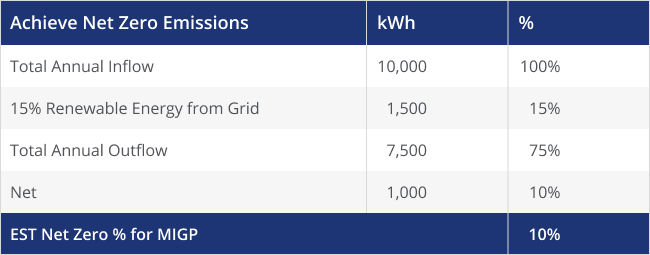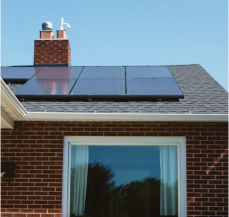Rooftop Solar and Private Generation
Thank you for your interest in helping create a clean energy future for Michigan. While DTE does not install rooftop solar systems for its customers, we have an important role to play in facilitating your system’s connection to the grid.
The Distributed Generation program is available to DTE Energy customers with qualified renewable energy on-site generation. Participating customers are compensated for energy they send into DTE’s distribution system when they fulfill DTE's Renewable Resource requirements.
Customers with private generation systems are still connected to the grid. Your DTE bill will reflect the cost of your service and any credits generated by your system.
Thinking of going solar? Here are some important things to consider before investing in a private system. If you are ready to proceed, please review our Interconnection Process and follow the steps to ensure the safety and reliability of your private generation system.
Rooftop Solar and Private Generation FAQs
Will DTE pay me for excess energy that I generate and outflow to the grid?
Yes. Customers generating electricity from renewable energy resources can be compensated for their excess generation. Customers with on-site renewable generation of 150 kW or less can qualify for service under DTE’s Distributed Generation program (Rider 18). For systems that do not meet the size or other qualification requirements of Distributed Generation, customers may call 313.235.4333.
What is inflow and the inflow charge?
Inflow is the electricity the customer uses from DTE and their distribution system. The inflow charge is for electricity flowing into a customer’s premise and is determined by the customer’s rate schedule.
What is outflow and the outflow credit amount?
Outflow is the electricity generated by the customer’s Distributed Generation project that is not used on-site and is instead sent to the electric grid. The outflow credit is the rate for each unit of energy in kilowatt-hours (kWh) that is exported from the customer to DTE’s distribution system. This credit is based on the power supply component of the customer’s retail rate, minus transmission charges. Outflow credits can be used in each billing period to offset power supply charges on the bill of the rate schedule to which Rider 18 is attached.
How does DTE estimate what size solar system a customer can install under the Distributed Generation program?
The program stipulates that the system is sized so the annual generation does not exceed the annual usage of the meter it is serving. Customers with questions regarding appropriate system sizing can call the DTE hotline at 313.235.4333.
Will customers continue to receive a bill from DTE after they have installed a private generation system?
Yes. Customers with private generation systems are still connected to the grid and receive energy from DTE when their personal system does not produce enough power to meet their needs. This is why customers will continue to see a charge for delivery services even after their system is operational.
Who should customers contact with questions about their bill after they have installed a private generation system?
For questions about billing once the customer’s system is operational, please call 800.482.8720 and select option #4.
When will customers start earning credit, if any, for their generation?
After a project successfully passes the DTE site inspection - the anti-islanding test is completed, and the meter has been reprogrammed - the solar panels will be left on and will begin generating energy.
When will I start seeing credits, if any, on my bill?
After a project successfully passes the DTE site inspection - the anti-islanding test is completed and the meter has been reprogrammed - the solar panels will be left on and will begin generating energy. The meter will then begin recording all inflow and any outflow. It generally takes 2-3 billing cycles for the customer’s bill to reflect participation in the Distributed Generation program and any outflow credits.
Will customers receive an energy credit or a monetary credit under the Distributed Generation program?
Customers will receive a monetary credit for their outflow. If a customer’s system outflows more kilowatt-hours to cover the cost of the power supply portion of their monthly bill, the “excess credit” will be “banked” and deducted from the power supply portion of a future bill. Excess credits can only be deducted from the rate schedule to which Rider 18 is attached.
How will the Distributed Generation program impact the customer’s electric bill?
The impact to the customer’s electric bill will depend on several factors, including energy consumption, generation, and system size. Interested customers can download this calculator and input inflow/outflow data to estimate the impact to their bill.
Does DTE require Distributed Generation or Net Metering customers to install battery storage?
No. DTE does not require customers to install battery storage.
Does a customer need to notify DTE if they are planning to add a battery storage system?
Yes. It is important for DTE to confirm that the customer’s battery will not interact with the distribution system. Both new and existing customers adding battery storage need to notify DTE, so the company can update the system information and help ensure the customer maintains eligibility for service under Distributed Generation or Net Metering. To submit a new application with the addition of a battery storage system, please visit DTE’s PowerClerk site.
Why is my battery storage not permitted to discharge energy to the grid?
Battery storage systems do not qualify as a renewable energy resource and therefore are not permitted to discharge energy back to the distribution system.
A customer owns or is considering purchasing an emergency generator for their home and business. Can they sell back the energy they don't use?
No. Customers cannot sell back energy from an emergency backup generator. An emergency generator is not an approved renewable energy resource and therefore is not eligible. Businesses with a generator that is greater than 250 kW may qualify for the Dispersed Generation tariff (Rider 13) and receive voluntary dispersed generation payments for operating their generation at the request of the DTE. For more information, call 800.482.8720 and select option #4.
Why are Net Metering customers being switched to the Distributed Generation Program?
By law, existing Net Metering customers will be converted to the Distributed Generation upon reaching their 10-year anniversary of participation in the Net Metering program. DTE will notify the customers of their upcoming 10-year anniversary in the Net Metering program approximately 30 days prior to their rate conversion via email.
Upon converting from Net Metering to Distributed Generation, will customers lose their Excess Generation Bank?
No. Customers converting to the Distributed Generation program will receive a check for their Excess Generation Bank balance, if applicable, approximately 60 days after their conversion.
How does this affect a SolarCurrents contract?
Moving to the Distributed Generation program does not affect SolarCurrents contracts. The SolarCurrents contracts were for the purchase of renewable energy credits for 20 years and will continue under the new program.
Can a customer expand their existing project size and remain on Net Metering?
A customer can expand their system; however, if they do, the entire system will be moved to the Distributed Generation program, not just the expansion.
Can a Distributed Generation (DG) customer enroll in the MIGreenPower program?
Yes, a DG customer can enroll in the MIGreenPower program as a simple and effective way to become a net zero carbon emission customer. Under DG, customers inflow electricity from the grid and receive credit for any outflow. As a result, DG customers may be interested in “greening” all their energy. In order to calculate the MIGreenPower subscription customers will need to look at their annual inflow and outflow. See below for a simple example:


Does DTE recommend working with particular solar installers?
No. DTE does not provide installer recommendations. However, Michigan Saves maintains a list of solar installers in Michigan. We encourage customers to do their research as they would for any major project or purchase. Consider requesting quotes from multiple companies, visiting the Better Business Bureau’s website, and reading reviews from credible sources.
Will customers who install solar on their home still lose power if DTE has a power outage?
Yes. Inverters are designed to shut off if the utility loses power, which is required by national standards for safety purposes. Customers with generation sources not connected to the grid (e.g., those with backup generators and/or battery storage) may avoid power loss in such instances.
A customer just purchased a home with solar panels, what do they need to do?
First, they should transfer the electric service into their name by calling 800.477.4747. Then they need to call the DTE Interconnection Hotline at 313.235.4333 and provide their name and address to have a new application created and approved. The new residents are also required to sign a new Parallel Operating Agreement. If the previous homeowner installed the system under the Net Metering program, the system will continue under the program for the remainder of the 10-year period before transitioning to the Distributed Generation program.
Contact Us
Billing Hotline
For Distributed Generation and Net Metering billing questions, please contact: 800.482.8720 and select option #4.
(For all other billing questions, contact: 800.477.4747)
Interconnection Hotline
For questions about new installations, current installations or other questions about the interconnection process, please contact us at 313.235.4333.
Note: The Interconnection Hotline is staffed Monday – Friday between 8 a.m. and 6 p.m. Callers can leave a message afterhours and will receive a call back within one business day.
